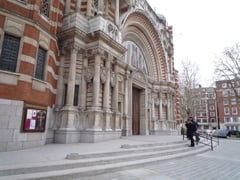Specialist stonework and restoration contractors Cathedral Works Organisation (CWO), working with St Ann’s Gate Architects of Salisbury who have been involved with the Cathedral since 1997, have built new ‘access for all’ ramps and steps in DeLank Cornish granite at the west front of Westminster Cathedral.
Westminster Cathedral in west London is the mother church of the Roman Catholic community in England and the largest Roman Catholic Church in England and Wales. Designed by Victorian architect John Francis Bentley and completed in 1903, the Cathedral is London’s only example of neo-Byzantine architecture, based on Mediterranean examples of early Christian churches using contrasting bands of terracotta, brick and Portland limestone.
The new arrangement of steps and ramps fit comfortably with the existing building, incorporating the same Cornish granite as was used on the original 100-year-old stone plinth. The shape of the steps form a welcoming arc into the Cathedral piazza with the ramps providing a gentle slope against the Cathedrals walls.
The works comprised the specialist cleaning of the original granite plinth, alterations to the existing ground level windows, and the removal of the existing paving plus the repairs to cracked brickwork of the lower brick facing facades.
CWO formed and cast the new reinforced concrete sub structure to the approved details and design and supplied and installed Cornish DeLank silver grey granite paving and steps.
The design of the steps included a rebated bronze inset strip to the leading edge of the granite, with two new bronze and seasoned oak handrails, plus bronze up lighters set into the ends of each monolithic step.
Westminster City Council re-engineered the piazza paving to meet the contours and curves of the new granite steps.
Neil Fairbairn, Clerk of Works, Westminster Cathedral, commented: “I am happy to say this was a trouble-free project. CWO carried out works efficiently with no health and safety issues and no public liaison problems. The end result is something that looks as though it has always been there.”

